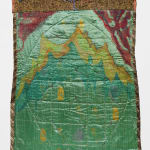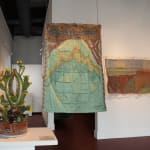-
Artworks




Consuelo Jimenez Underwood American, b. 1949
Undocumented Nopal. 2525 AD, 2019Stitched, woven, embroidered, and silkscreened. Silk and cotton fabric. Linen, Kentucky barbed wire, cotton, and synthetic thread70 x 48 in
177.8 x 121.9 cmFurther images
Jimenez Underwood’s Undocumented Nopal 2525 AD depicts a nopal cactus, embroidered with barbed wire as its spikes, engulfed in flames, echoing the artist’s environmental concern for our planet. The work...Jimenez Underwood’s Undocumented Nopal 2525 AD depicts a nopal cactus, embroidered with barbed wire as its spikes, engulfed in flames, echoing the artist’s environmental concern for our planet. The work depicts a post-apocalyptic cactus, referencing the resilience of nopals, native to North America, and can be used for food, medicine, and even dye mordant. Ecosystems of flora and fauna continue to pass through man-made borders, a theme the artist continually examines. "Indigenous foodstuffs, plants native to the Americas, and when the artist elevates chili, chocolate, and nopal to the sacred level, these plants in all their mundane and symbolic power become aspects of the Goddess of the Americas." Anne Marie Leimer, "Garments for the Goddess of the Americas," Consuelo Jimenez Underwood: Art, Weaving, Vision, Duke University Press, 2022Exhibitions
Threading Glass: Consuelo Jimenez Underwood, and Einar and Jamex de la Torre, Ruiz-Healy Art, San Antonio, TX, 2025
Consuelo Jimenez Underwood: One Nation Underground, Ruiz-Healy Art, San Antonio, TX, 2022
Woven: Connections and Meanings, National Museum of Mexican Art, Chicago, IL, 2019
Literature
Purcell, Barbara. “Indivisible: Consuelo Jimenez Underwood’s “One Nation Underground” at Ruiz-Healy Art,”
Glasstire, December 14, 2022 (illustrated)
Publications
Laura E. Perez and Ann Marie Leimer, eds., Consuelo Jimenez Underwood: Art, Weaving, Vision, Durham, North Carolina: Duke University Press, 2022, between pages 160-161 (illustrated)








